The National Memorial for Peace and Justice
The National Memorial for Peace and Justice, informally known as the National Lynching Memorial,[1] is a national memorial to commemorate the Black victims of lynching in the United States. While White individuals were also lynched, this memorial is intended to focus on and acknowledge past racial terrorism and advocate for social justice in America. Founded by the non-profit Equal Justice Initiative, it opened in downtown Montgomery, Alabama on April 26, 2018.[2][3]
 The memorial includes 805 hanging steel rectangles, representing each of the counties in the United States where a documented lynching took place | |
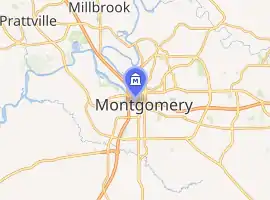
| |
| Established | April 26, 2018 |
|---|---|
| Location | Montgomery, Alabama |
| Coordinates | 32°22′19″N 86°18′46″W |
| Founder | Equal Justice Initiative |
| Website | Official website |
Background
The memorial was built on six acres in the downtown area of the state capital by the Equal Justice Initiative (EJI), a non-profit based in Montgomery. The related Legacy Museum: From Enslavement to Mass Incarceration opened the same day. The complex was built near the former market site in Montgomery where enslaved African Americans were sold.[4] The development and construction of the memorial complex cost an estimated $20 million, raised from private foundations.[5] Bryan Stevenson, founder of the EJI, was inspired by the examples of the Memorial to the Murdered Jews of Europe in Berlin, Germany, and the Apartheid Museum in Johannesburg, South Africa, to create a single memorial to victims of white supremacy in the United States.[6]
By studying records in counties across the United States, researchers documented almost 4400 "racial terror lynchings" in the post-Reconstruction era between 1877 and 1950. Most took place in the decades just before and after the turn of the 20th century.[7][3][8] An error at the memorial in the name of a victim from Duluth, Minnesota, was quickly corrected.[9]
Description
In the central position is the memorial square with 805 hanging steel rectangles, the size and shape of coffins. These name and represent each of the counties (and their states) where a documented lynching took place in the United States, as compiled in the EJI study, Lynching in America: Confronting the Legacy of Racial Terror (2017, 3rd edition). Each of the steel plates also has the names of the documented lynching victims (or "unknown" if the name is not known). The names and dates of documented victims are engraved on the panels. More than 4075 documented lynchings of African Americans took place between 1877 and 1950, concentrated in 12 Southern states. In addition, the EJI has published supplementary information about lynchings in several states outside the South. The monument is the first major work in the nation to name and honor these victims.[10]
The central memorial was designed by MASS Design Group[11] with Lam Partners lighting design,[4] and built on land purchased by EJI.[2][12] Hank Willis Thomas's sculpture, Rise Up, features a wall, from which emerge statues of black heads and bodies raising their arms in surrender to the viewer. The piece suggests visibility, which is one of the intentions of the monument. The viewer is asked to focus and see the subject of the artwork. This is a more current piece[13] commenting on the police violence and police brutality prevalent in the years preceding the memorial. Thomas has said about his artwork, "I see the work that I make as asking questions."[14]
In the landscaped area outside the monument are benches where visitors can sit to reflect. These are dedicated to commemorating such activists as journalist Ida B. Wells, who in the 1890s risked her life to report that lynchings were more about economic competition of blacks and whites, than actual assaults by blacks of whites.[15] Laid in rows on the ground are steel columns corresponding to those hanging in the Memorial. These columns are intended to be temporary. The Equal Justice Initiative is asking representatives of each of the counties to claim their monument and establish a memorial on home ground to lynching victims, and to conduct related public education.[16]
A month after the monument's opening, the Montgomery Advertiser reported that citizens in Montgomery County were considering asking for their column. Both county and the city of Montgomery officials were also discussing this.[17]
Analysis on central monuments
The National Memorial is not only America’s first lynching museum, but also features artists that speak of prominent issues including slavery, segregation, and police brutality as connected phenomena of lynching in America. Thus, EJI uses the National Memorial to tell a well-rounded story on the continuities of racial violence by connecting the past and the present mistreatments of Black people in America. The selected sculptors for the National Memorial represent a diverse background and connection to racial violence, further demonstrating the global nature of Black tragedy that the memorial works to put on display.
Nkyinkyim by Kwame Akoto-Bamfo
The Memorial is organized in three different sections. The first section is the lead up to the monument which begins to tell the tale of the beginning of the lives of African Americans through the demonstration of the racial terror evoked in the Middle Passage.[18] Thus, upon entering the memorial, visitors first encounter a sculpture by Ghanaian artist Kwame Akoto-Bamfo entitled Nkyinkyim. The sculpture is a part of larger project Akoto-Bamfo began in Accra, Ghana where he creates clay busts of formerly enslaved people in an attempt to preserve their memories and livelihood, a common tradition practiced by the Akan people in Ghana.[19] Akoto-Bamfo inspiration from his project in Ghana, propelled him to translate Nkyinkyim sculpture for the National Memorial. Nkyinkyim is a portrayal of seven shackled figures of all ages and genders interlocked together at the beginning of the journey through the memorial. The word “nkyinkyim: is an Akan word from the Asante people meaning twisted and it is related to the Ghanaian proverb that “life is a twisted journey.”[19] This sculpture begins to set the tone for the twists, trials, and tribulations Black people encounter not only through their journey but their settlement into the States. Furthermore, from the very beginning, this sculpture is to indicate the centrality of diasporic understanding in both the conversation of slavery and lynching in America. In fact, Akoto-Bamfo’s partnership with EJI itself begins to draw those narratives of connectivity, pain, and resilience as their seemingly distinct lives and goals begin to merge and connect to tell a fuller story of the lives of those lost and stripped as a result of slavery.
A common understanding of the Middle Passage is the stripping of Africans identity through the loss of names, ethnic identity, families, and more. The Nkyinkyim sculptures include description and details of each shackled person portrayed. Therefore, from the moment visitors engage with the memorial, they encounter the beginning of a rewriting of history where Akoto-Bamfo reasserts the humanity of these enslaved people. As visitors engage by reading the descriptions of these people, they are also actively working to realize their humanity and their existence past being sources of labor production, but as people. Akoto-Bamfo gives these individual sculptures different backgrounds ranging from “Daughter of a Royal” to “Uncle’s Brother” to “The Lost Guardian” demonstrating the lives these enslaved people left behind and the diverse and range of backgrounds that was reflective in this capturing.[20] It reveals the nondiscriminatory nature of the slave trade, as it made all Africans susceptible to dehumanization. However, despite Akoto-Bamfo’s attempt to reclaim some of the identities lost through the naming of his sculptures, these names are still mere descriptors, bringing the audience back to an understanding a reality of the stripping and loss of identity and livelihood as a symptom of the institution of slavery.
The composition of the sculptures continues to tell a powerful story as Akoto-Bamfo focuses on the individuality of each face and the grievances and different kinds of pain they are experiencing. For instance, the “Daughter of a Royal” is distinguishable from the other sculptures because of her hairstyle, positioning her past life as someone of influence.[20] Thus, her pain and acceptance of her reality is one shaped by her apprehension to accept her new status, to become like the others. The audience watches as she loses her privilege. However, these seven figures are all the same in that they are shackled and naked as red copper runs down their bodies, imitating blood and thus the hardships yet to come. To some extent, their enslavement has become a great equalizer among them, something they also continue to grieve.
Guided by Justice by Dana King
Another sculptor, Dana King, creates her rendition of the Montgomery Bus Boycott during the Civil Rights Movement through her sculpture “Guided by Justice.” King’s sculpture is of three women: a grandmother, a teacher, and a pregnant woman. King plays homage to the work of women to catapult the effectiveness of the 13-month bus boycott. Amidst the bronze statues of the women, there are footprints on the ground near them, seeming to represent a call to action for other women and people passionate about the movement to join them in the cause.[21] As a result, King’s sculpture begins to also rewrite the history around the heroines of the bus boycott. Through the mythologization of historical figures like Rosa Parks, history has forgotten the thousands of other black people who were central in the success of the bus boycott. Thus, King’s rendition of these three figures and the adjacent footprints, demonstrates the importance of these “silent activists.[22]” King interestingly chooses to represent only women, thus also working to demonstrate the central role women play in the success of the boycott and largely the civil rights movement, a concept that has been overshadowed by men.
Furthermore, what is beautiful about this sculpture is the cotidal nature of it as it demonstrates these three normal women. This sculpture can also be seen as a politicization of the black woman’s body as its own kind of monument, showing that the accumulation of black women can be so powerful that it yields large historical implications and can begin the tide for a global movement like the Civil Rights Movement. Thus, this seemingly small gesture of helping to elongate the bus boycott led the way for the continuation of non-violent protests further upheld by the Freedom Fighters and civil rights protests seen in Selma.[21] King’s sculpture leads the way in demonstrating the impact that Black women have in influencing and leading the work for towards Black freedom.
Finally, King’s representation of three distinct kind of women also demonstrates the variety of people willing to fight emphatically for the cause. The grandmother represents a kind of nurturer, a woman passing down this informal knowledge as she leads the pack. She represents a kind of generational memory that the younger women behind her do not yield, and thus a possible better understanding on the forms of violence Black people have had to face. In the back, the teacher is representative of the influence of teachers in the fight for freedom as it contextualizes formative event in the fight for equality such as Brown v Board of Education decision in 1954. The last woman is a young pregnant woman who may represent a form of possible rebirth and a hopefulness to help to create a new future that is safer for Black children and young black lives.[23]
Raise Up by Hank Willis Thomas
The journey through the memorial continues with Hank Willis Thomas’ sculpture, “Raise Up,” a depiction of policing in America. The sculpture depicts ten black men, encased in cement, some with their heads sunken into the concrete with their hands up and their eyes closed.[21] Thomas’ sculpture is a powerful evocation of the reality of Black men in America when coming face to face with law enforcement. Thomas interestingly encases these black men in cement, leaving them unable to move, thus demonstrating this inescapable nature from impending doom and death Black people in America feel when facing police. However, it is not just their bodies that are submerged, but some figures heads are sunken in as well, further demonstrating the lack of control and autonomy Black people have over their bodies. In fact, the cement seems to represent the policing system—all-consuming and unrelenting. Yet, despite the majority of their bodies being covered, the hands of all the figures are clearly visible. Thus, Thomas’ depictions harken back to the countless stories of unarmed Black men being shot and brutalized by the police despite their innocence, as demonstrated by the raised hands. As the last monument, the National Memorial uses Thomas’ sculpture as a connection to the present, a kind of call to action that the fight for justice and liberation is ongoing.[21]
Impact of memorial after 2017 Charlottesville Rally
The National Memorial for Peace and Justice opened after the Charlottesville Rally in 2017 where white supremacists gathered to protest the removal of Confederate general Robert E Lee’s statue. Three people died from the rally, with one death resulting in a woman who was allegedly purposefully hit by a protestor.[24] However, the rally was more than just a rebellion over the possible replacement of this statue. Instead, many scholars have discussed that the rally was to redefine the use of public space through the assertion of a white racial authority.[25] As a result, with the opening of the National Memorial almost a year later, the work of the Equal Justice Initiative works to question the authority of whiteness in defining public space by creating a setting and a space that unapologetically calls out white racial terror. The Charlottesville rally was another demonstration of the easy and natural memorialization of whiteness in public spaces from the statue of Robert E Lee to bridges, buildings, and parks sprawled across the country named not only after white people, but white leaders who were explicitly against the existence and flourishing of black people in America. The National Memorial calls into question the kinds of figures we decide to memorialize by bringing to the forefront the very racist and harmful impact that these national leaders have caused. Thus, the National Memorial begins to transform not only our conceptualization of racial terror through the display of white violence, but also pushes its viewers to reconsider memory in American values as it calls for a confrontation of America’s past.[21]
Importance for Montgomery tourism
Prior to the 1990s, there was limited acknowledgement in Montgomery to the painful legacy of slavery and racism, although the city had numerous monuments related to the Confederacy, many erected by private organizations. The city has developed a Civil Rights trail marking such events as the 1965 Selma to Montgomery marches, and also identified buildings and sites associated with slavery, such as the former market site.[26] With the opening of the monument, the city was ranked by the New York Times as its Top 2018 Destination.[27] Lee Sentell of the Alabama Department of Tourism acknowledged that the National Memorial offers a different and painful encounter: "Most museums are somewhat objective and benign...This one is not. This is aggressive, political. ... It's a part of American history that has never been addressed as much in your face as this story is being told".[26] Mayor Todd Strange suggested that the memorial offered "our nation's best chance at reconciliation".[28]
The opening celebrations, in May 2018, attracted thousands of people to Montgomery,[28] perhaps as many as 10,000. Artists who performed included Stevie Wonder, Patti LaBelle, and Usher; speakers included U.S. Congressman and civil rights movement activist John Lewis from Georgia.[29]
The memorial and its attendant museum are expected to generate heightened tourism for Montgomery,[30] even if it is dark tourism.[27] The Atlanta Journal-Constitution noted that, with the addition of the memorial and the museum, Montgomery and Atlanta together provide a narrative of African-American history, as the latter has sites associated with national civil rights leader Rev. Martin Luther King Jr. and local history as well.[30] Tourism officials said that possibly 100,000 extra visitors per year may arrive.[31][32]
The Legacy Museum
.jpg.webp)
Opened on the same date as the outdoor memorial, The Legacy Museum: From Enslavement to Mass Incarceration is a museum that displays and interprets the history of slavery and racism in America. The progress through the museum is chronological, beginning with slavery, and passing through the decades of lynching, extrajudicial violence against blacks, through the Civil Rights era, and dealing with present issues.[11] This includes the enslavement of African-Americans, racial lynchings and disenfranchisement of black voters, segregation and Jim Crow, and racial bias. Artwork in the museum includes a sculpture on slavery by Ghanaian artist Kwame Akoto-Bamfo, at the beginning; a sculpture "dedicated to the women who sustained the Montgomery Bus Boycott" by Dana King, to help illustrate the Civil Rights period; and a piece about today's police violence and the biased criminal justice system, by Hank Willis Thomas.[11]
The museum features artwork by Hank Willis Thomas, Glenn Ligon, Jacob Lawrence, Elizabeth Catlett, Titus Kaphar, and Sanford Biggers. One of its displays is a collection of soil from lynching sites across the United States.[5] This exhibit expresses the vast effects of slavery, lynchings, and black oppression across state lines. The exhibits in the 11,000-square-foot museum include oral history, archival materials, and interactive technology.[33]
Publishers of the Montgomery Advertiser reviewed and formally apologized for its historic coverage of lynchings, which was often inflammatory against black victims, describing it as "our shame" and saying "we were wrong".[34][35]
Lasting Impact of National Memorial for Peace and Justice
The National Memorial of Peace and Justice begins to follow the world trajectory of monuments, especially as seen in Europe, as not only a way to begin to deal with a nation’s past, but specifically the shame, guilt, and trauma of those whose voices have been historically silenced. The work of EJI is one of a rewriting and to some extent, a forced reconciliation of America’s violent past against Black people. Though the memorial is centered around the prevalence of lynching, it takes its viewers on a journey from enslavement to modern mass incarceration, demonstrating the different forms of lynching that Black populations face and continue to face. This journey makes the monumentation and memorialization of this pain something that is alive, unresolved, thus pushing towards this reconciliation.
Gallery
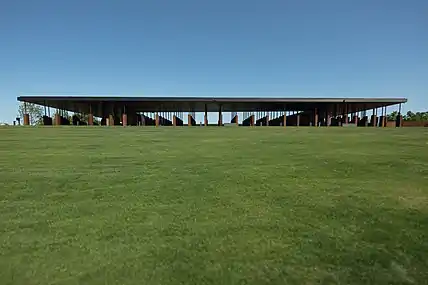 Outside view of the memorial
Outside view of the memorial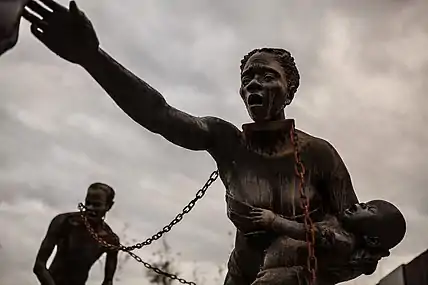 Installation by Kwame Akoto-Bamfo
Installation by Kwame Akoto-Bamfo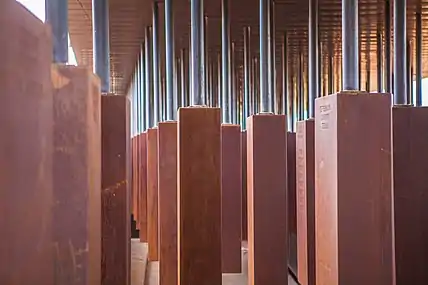 Memorial Monuments
Memorial Monuments Installation by Hank Willis Thomas
Installation by Hank Willis Thomas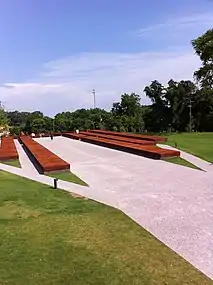 Steel columns intended for each county
Steel columns intended for each county.jpg.webp) National Memorial for Peace and Justice Center
National Memorial for Peace and Justice Center.jpg.webp) National Memorial for Peace and Justice Garden
National Memorial for Peace and Justice Garden
See also
- List of lynching victims in the United States
- List of museums focused on African Americans
- National Museum of African American History and Culture
- Topography of Terror, a museum in Berlin dedicated to the victims of the Nazi regime
References
- Capehart, Jonathan (December 21, 2016). "What the lynching memorial will force us all to face". The Washington Post. Retrieved January 15, 2017.
- "The Memorial for Peace and Justice". Equal Justice Initiative. Retrieved June 11, 2020.
- Campbell Robertson (April 25, 2018). "A Lynching Memorial Is Opening. The Country Has Never Seen Anything Like It". The New York Times.
- Edgemon, Erin (August 16, 2016). "Nation's first memorial to lynching victims, museum set for Montgomery". The Birmingham News. Retrieved August 23, 2016.
- Miller, James H. (April 16, 2018). "Alabama memorial confronts America's racist history". The Art Newspaper. Retrieved April 20, 2018.
- Robertson, Campbell (April 25, 2018). "A Lynching Memorial Is Opening. The Country Has Never Seen Anything Like It". The New York Times. Retrieved April 26, 2018.
- Robertson, Campbell (February 10, 2015). "History of Lynchings in the South Documents Nearly 4,000 Names". The New York Times. ISSN 0362-4331. Retrieved April 26, 2018.
- "Equal Justice Initiative's report". Equal Justice Initiative's report. Retrieved April 26, 2018.
- Weber, Tom (June 5, 2018). "National lynching memorial: A jarring, but understandable error to remember Duluth victim". Minnesota Public Radio. Retrieved June 8, 2018.
- Song, Jean (August 16, 2016). "Alabama lynching memorial aims to confront ramifications of slavery". CBS News. Retrieved August 23, 2016.
- Wright, Barnett (April 19, 2018). "What's inside Montgomery's national peace and slave memorial museum opening April 26". Birmingham Times. Retrieved April 21, 2018.
- "EJI Announces Plans to Build Museum and National Lynching Memorial". Equal Justice Initiative. August 16, 2016. Retrieved August 23, 2016.
- "A New National Memorial To Victims Of Lynching". 1A. April 24, 2018. Retrieved May 2, 2018.
- Cosgrove, Adenike (April 22, 2018). "Artist Spotlight: Hank Willis Thomas, United States". Imodara magazine. Retrieved May 2, 2018.
- Brown, DeNeen L. (April 26, 2018). "Ida B. Wells: Lynching museum, memorial honors woman who fought lynching". The Washington Post. Retrieved April 27, 2018.
- Henderson, Nia-Malika (April 9, 2018). "This new lynching memorial rewrites American history". CNN. Retrieved April 12, 2018.
- Edwards, Brian (May 23, 2018). "Montgomery County in talks to accept EJI monument". Montgomery Advertiser. pp. 1, 6A.
- Trent, Noelle (2019). "Museum and Exhibit Reviews". The Public Historian.
- Das, Jareh (2020). "Kwame Akoto-Bamfo's Sculptural Installation in Ghana Re-Narrativizes the Transatlantic Slave Trade".
- Matchan, Linda (2020). "Bearing witness to slavery: A sculpture's trans-Atlantic passage from Ghana to Alabama". The Boston Globe.
- Schult, Tanja (2020). "Reshaping American Identity: The National Memorial for Peace and Justice and its Take- Away Twin" (PDF). Liminalities: a Journal of Performance. 16: 45.
- Jones, Kevin (2020). "KPIX Anchor-Turned-Sculptor Contributes Piece to Lynching Memorial".
- Rooney, Sierra (2020). "Monumental Women: Gender, Place, and Heroism in American Public Statues".
- Dwyer, Colin (2017). "Charlottesville Rally Aimed To Defend A Confederate Statue. It May Have Doomed Others".
- Nelson, Louis (2018). "Object Lesson: Monuments and Memory in Charlottesville". Buildings & Landscapes: Journal of the Vernacular Architecture Forum. 25: 18.
- Elliott, Debbie (April 26, 2018). "New Lynching Memorial Is A Space 'To Talk About All Of That Anguish'". NPR. Retrieved June 8, 2018.
- Baxter, Tom (June 4, 2018). "Dark Tourism: The world comes to Montgomery". Saporta Report. Retrieved June 8, 2018.
- "Montgomery: 'Where past, present and future intertwine'". Montgomery Advertiser. May 31, 2018. Retrieved June 8, 2018.
- Brooks, Jalea (April 27, 2018). "National Memorial for Peace and Justice Grand Opening". Alabama News. Retrieved June 17, 2019.
- "Heading to Montgomery? Make time for Atlanta's King sites". The Atlanta Journal-Constitution. Associated Press. May 16, 2018. Retrieved June 8, 2018.
- Riales, Bill (May 17, 2018). "Lynching Museum could boost tourism". WKRG. Retrieved June 8, 2018.
- "Lynching memorial could turn Montgomery into tourist hot spot". The Birmingham News. Associated Press. May 16, 2018. Retrieved June 8, 2018.
- Dafoe, Taylor (April 26, 2018). "A Look Inside the New Alabama Museum and Memorial Boldly Confronting Slavery and Its Brutal Legacy". Artnet. Retrieved April 26, 2018.
- Lyman, Brian (April 20, 2018). "'There will be lynchings': How the Advertiser failed victims of racial terror". Montgomery Advertiser.
- Montgomery Advertiser Editorial Board (April 26, 2018). "Our shame: The sins of our past laid bare for all to see". Montgomery Advertiser.
External links
| Wikimedia Commons has media related to Memorial for Peace and Justice. |